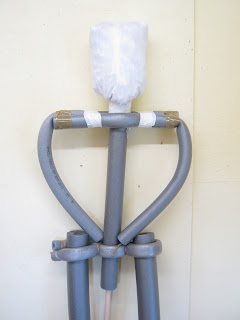I’ve made some modifications to the soft-bodied
armature that I used for Farmer George (see my blog for Monday 8th
April 2013). A visit to B&Q established that Climaflex foam pipe insulation
comes in 2 metre lengths, and a variety of at least three diameters: 48 mm, 65 mm and 78 mm.
Each ‘crow’ takes one thick tube cut in two for the
legs, half a thinner tube for the torso, one thin tube for the arms and half a
thin tube for the hips. The finished ‘crow’ is light and flexible. I’ll be
offering him as an alternative to the freestanding ‘crow’ at tomorrow’s
workshop.
This scarecrow’s torso can be strengthened by
pushing a length of wooden dowel up the centre of the pipe. The dowel can
either be short, just long enough to stiffen the neck whilst leaving the ‘crow’
able to bend at the waist, or long so that the whole of the torso is strengthened.
The dowel can even be long enough to act as a centre post that can be pushed
into the ground to support the scarecrow.
Remember to drive a hole into the ground using a
separate piece of dowel or rod, as the ‘crow’ itself will not be able to
withstand being driven into hard ground.
The hips and legs are made by cutting the thickest
diameter pipe in two to make two legs, each a metre long, before winding the
half of the thin tube round the top of one leg, interlacing it at the bottom of
the torso, and then again at the top of the other leg, securing each twist with
strong twine or string as you go. The hips hold the legs in place by natural
friction.
Two pieces of wooden dowel can be inserted, one
down the centre of each leg, so that the legs are stiff and can support the
scarecrow when the free ends are put in the ground. As before, the holes needs
to be made first, so do not try to push the dowels that stiffen the legs
straight into the ground without first preparing two holes to receive them.
The arms are made by overlapping two of the thin
pipes to form the shoulders and taping the ends. The torso pipe can then be
inserted into the space formed between the shoulders, where the arm pipes
overlap. The arms can be posed.
At this stage, if gently encouraged the shoulders
will slide up and down the torso. Slide them down, and place a face bag lined
with a plastic bag over the top of the torso, stuff it with scrunched up
newspaper, and seal the neck end with builder’s tape. Trim away any surplus and
slide the shoulders back up to the neck. Secure the shoulders more firmly at
the neck with builder’s tape.
The torso can be ‘dressed’ with a T-shirt, and
stuffed. The arms and legs can also be padded out in the usual way, but
depending on how you want your ‘crow’ to look, this may not be necessary. The arms, legs and torso can all be trimmed shorter with scissors if a 'crow' of smaller proportions is required.




No comments:
Post a Comment